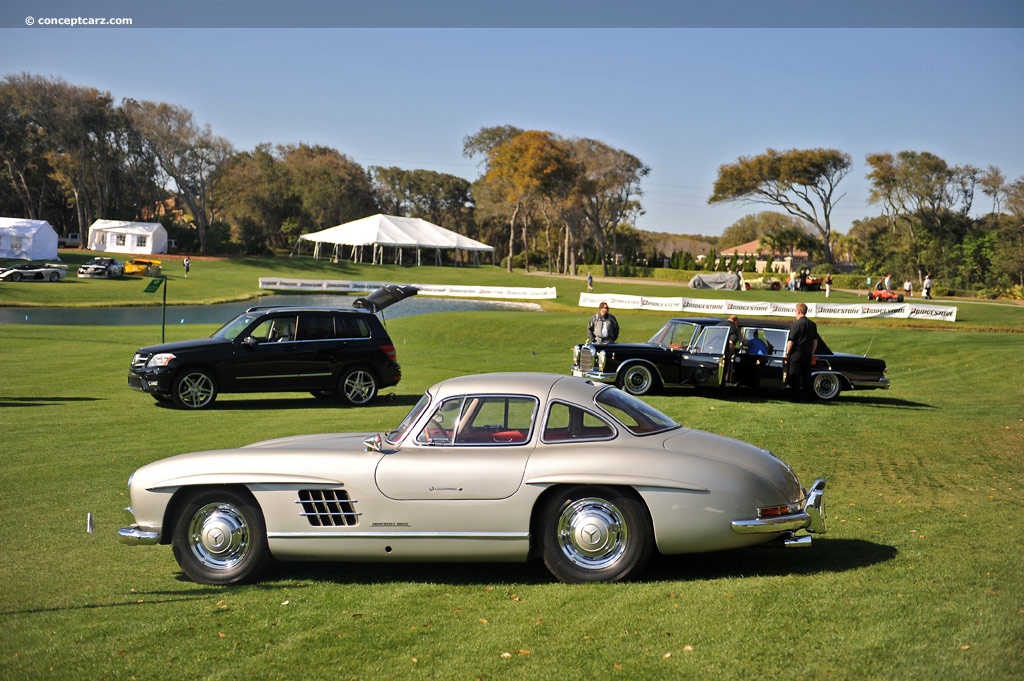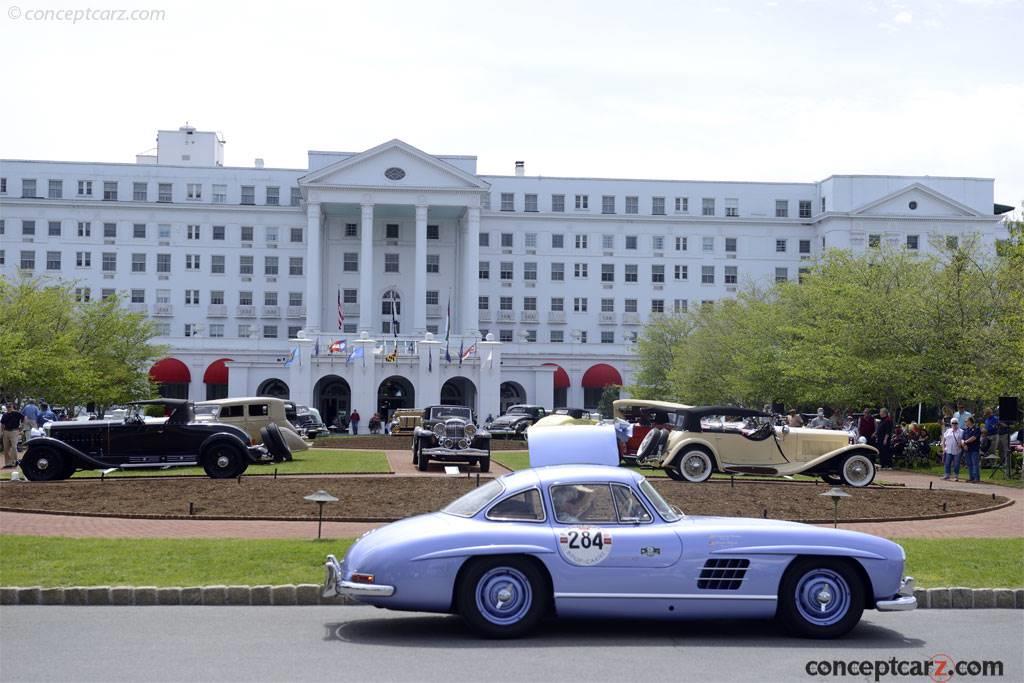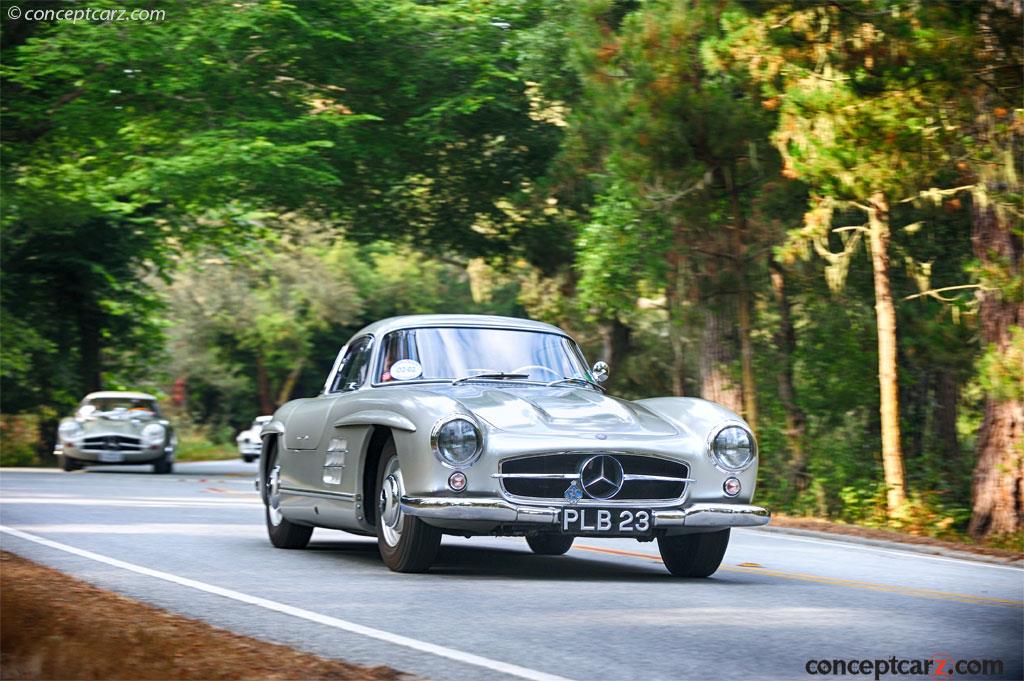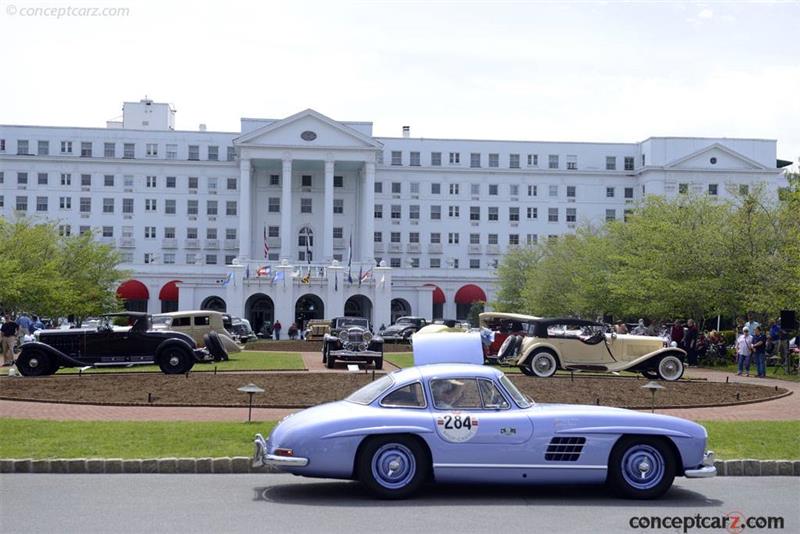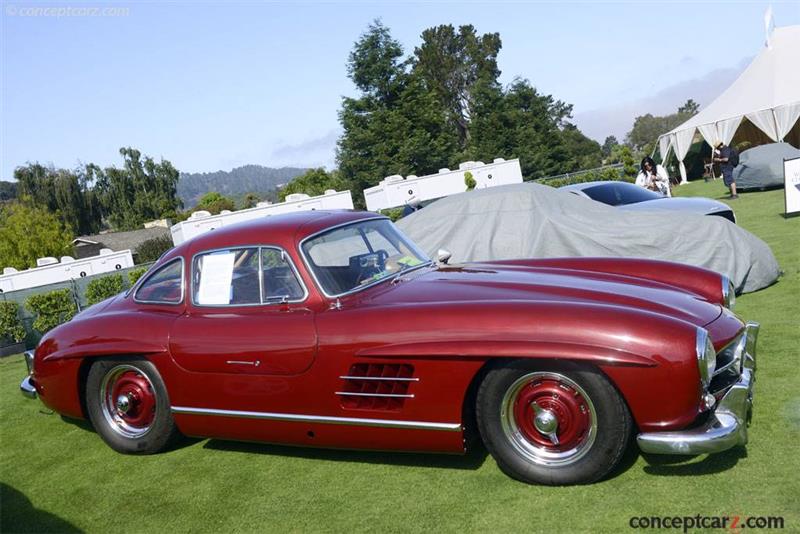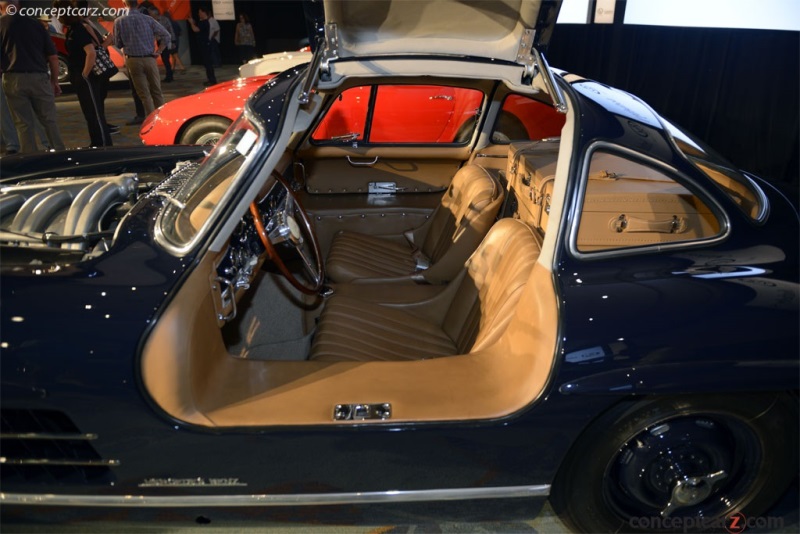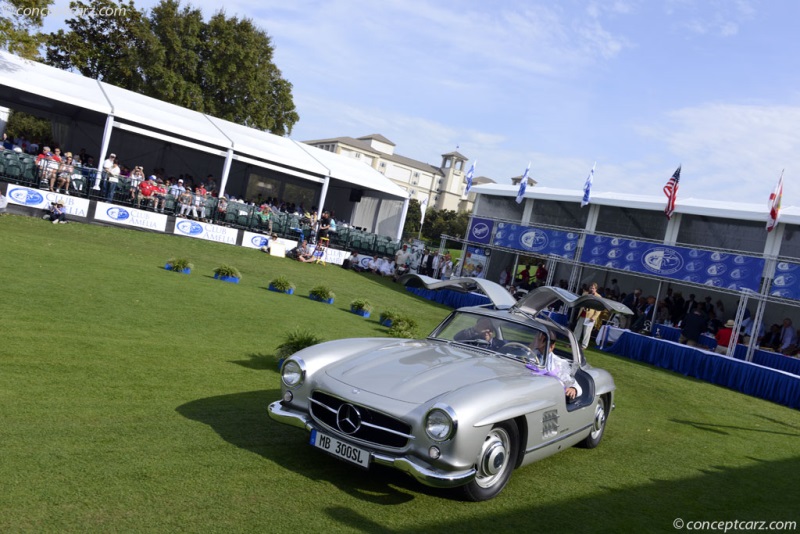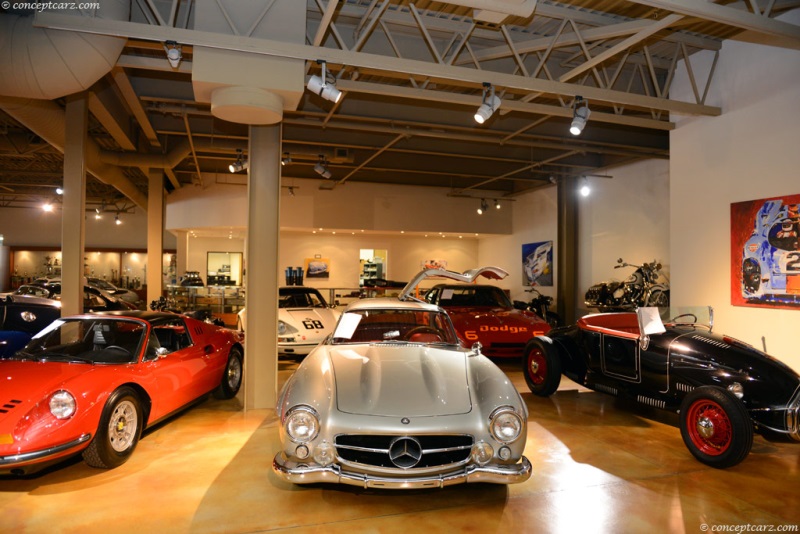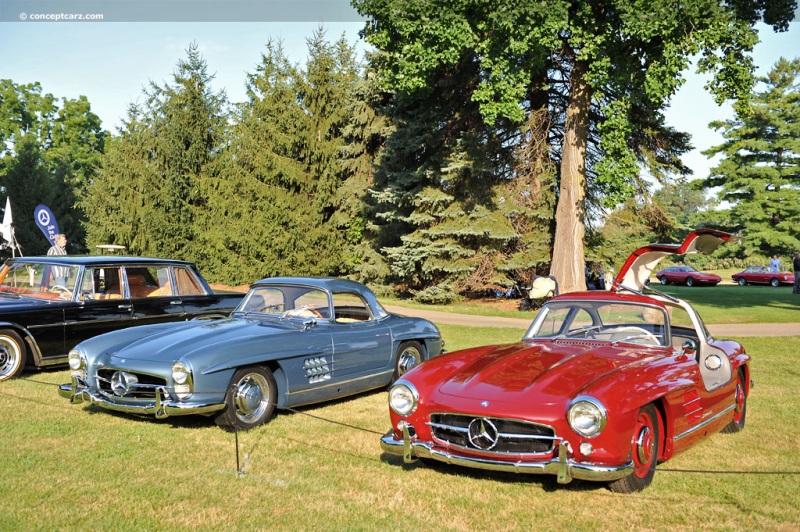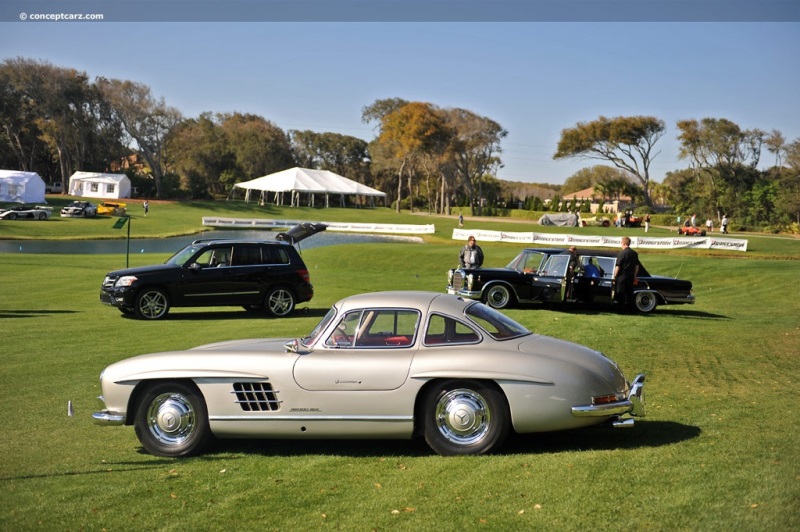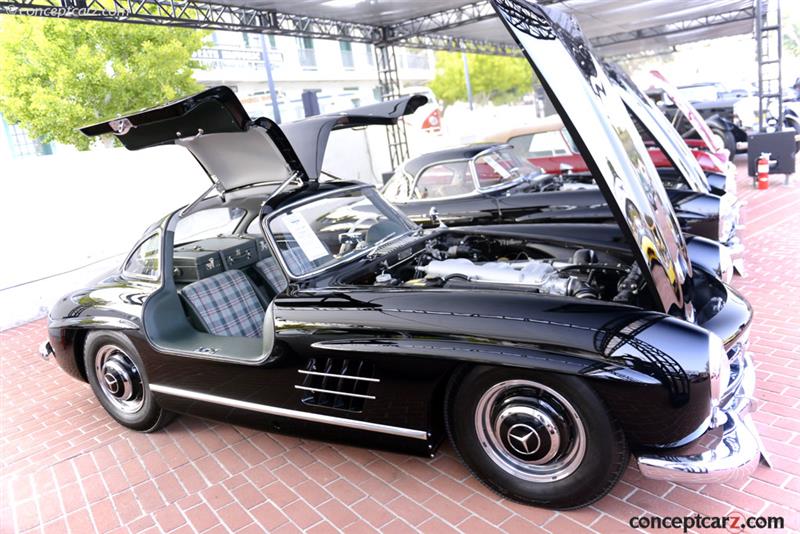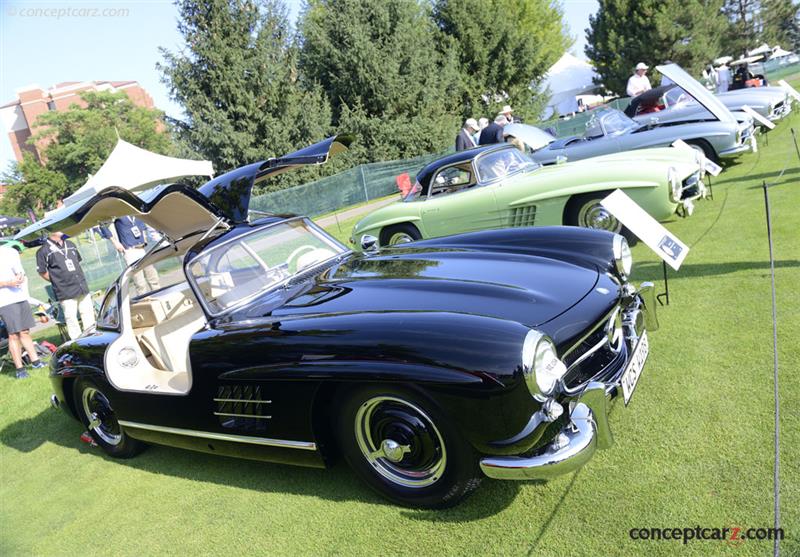The Mercedes-Benz 300SL W194 competition coupe was aimed at contesting the World Sportscar Championship which was dominated in the post-war era by Alfa Romeo, Ferrari, and Lancia. Designed by Chief Engineer Fritz Nallinger, Mercedes-Benz's two-seat sports car came equipped with an inline, single overhead camshaft (SOHC) six-cylinder engine from its luxurious 300 series. The rather heavy drivetrain and engine were complemented by a lightweight chassis. Test Department manager Rudy Uhlenhaut and construction engineer Joseph Müller devised a lightweight (154 pound) and rigid lattice-work chassis capable of housing and coping with the inline-six. Since conventional doors would compromise the rigidity of the chassis, the solution was to raise the entry so that the doors cut into the roof. This meant that the doors would be hinged from the top, birthing the car's signature 'Gull Wing' door design feature. The steering wheel was hinged to allow the driver easier access. The engine was laid over at a steep angle allowing for a reduced front aspect and improved aerodynamics. Auto Motor und Sport wrote introduced the world to the new aluminum-bodied 300SL Coupe prototype fitted with twin Weber carburetors in their January 1952 issue, reporting that at a December test session at Hockenheim, factory driver Karl Kling had driven to speeds in excess of 118 mph and top speeds of approximately 150 mph. The racing debut of the 300SL was in 1952 at the Mille Miglia where Kling placed second while Rudy Carraciola was fourth. At the Grand Prix of Berne, a quartet of 300SLs contested the race and swept the top three positions, Carraciola having crashed in what would prove to be his last race. At the 24 Hours of LeMans, a pair of 300SLs finished in the top two positions. After the race, the two cars were driven back to the factory. Four topless roadsters raced at the German Grand Prix and claimed the top four finishing positions. A pair of coupes and a pair of roadsters competed in the third Carrera Panamericana sports car race in Mexico in November 1952, with Karl Kling and Hermann Lang capturing the top two positions, beating a Lancia and three Ferraris. During 1953 and 1954, Mercedes-Benz concentrated its efforts on developing its new Grand Prix car, and many of the technologies and lessons learned from those efforts were implemented on the SL when it reappeared in 1955. The 300SLRs were victorious in Buenos Aires and the Mille Miglia, where Stirling Moss and Denis Jenkinson won at a record average speed of just under a hundred miles an hour. It won at the Nurburgring, Spa, Zandvoort, Aintree, Kristianstad, Monza, Dundrod, and Sicily's Targa Florio. Mercedes-Benz's epic 1955 racing season came to an abrupt end in 1955 when a tragic accident at Le Mans claimed the life of team driver Pierre Levegh and more than 80 spectators. This was one of racing's worst accidents, prompting Mercedes Benz to withdraw from racing for many years.While the racing legacy of the 300SL was coming to a close, its road-going resume was just beginning. United States importer Max Hoffman understood the emerging American market for European sports cars during the 1950s and made considerable efforts to convince Mercedes-Benz that a niche existed for a road-going series-production version of the 300SL race car. Although the company was reluctant, Hoffman quieted their fears by placing an order for 1000 units. Clearly intended for the American market, the 300SL Gullwing in road-going guise was unveiled at the New York International Motor Sports Show in early February 1954, and actual production began that fall. Its design was faithful to the racing version and had changed only slightly, albeit heavier than the racing model. The 2996cc SOHC 6-cylinder engine was equipped with Bosch Mechanical Fuel Injection and delivered 240 horsepower at 6,100 RPM. It was backed by a four-speed manual transmission, an independent suspension setup, and four-wheel drum brakes. The tubular frame rested atop a steel chassis and was clothed with a steel body. The trunk (boot) lid, doors, bonnet, and dashboard were built from aluminum. Twenty-nine examples were built with a lightweight but expensive all-aluminum body. Zero-to-sixty miles an hour was accomplished in less than nine seconds, 100 mph in 18 seconds, and could easily top 75 mph in second gear. The factory declared it 'the fastest German production sports car'.The interiors were offered with three checkered pattern seat fabrics consisting of grey/green, cream/red, and grey/blue. Most customers selected the leather upholstery, which was standard on the Roadster. Luggage space was minimal as the trunk was filled by the spare wheel and fuel tank, leaving the area behind the seats as the only storage space. The Roadsters could be optioned with two custom-fitted leather suitcases for the larger trunk. The windows in the Roadster could be rolled down, while the Coupes were fixed.The road-going version had a more luxurious cabin than its racing sibling, and the doors were cut substantially lower for easier entry and exit. The mechanical fuel injection system of the road car increased output by an additional 44 horsepower and is notable as the first production automobile to feature the since widely copied method of fuel induction.During the production lifespan of the 300SL, numerous subtle mechanical developments were undertaken including a revised position for the shifter, a re-designed clutch assembly, and adoption of Daimler-Benz's proprietary recirculating-ball steering system. The final drive ratio of 3.64:1 was eventually made a standard specification, while other ratios were available as options.Among the list of optional equipment included a Becker radio, an accessory luggage set, various rear-axle ratios, and chromed Rudge wheels. The Gullwing was produced from 1954 to 1957 with a total of 1,400 examples produced. In 1957, the 300SL roadster was introduced and 1,858 examples were built before production ended in 1963.
by Daniel Vaughan | Sep 2021
by Daniel Vaughan | Sep 2021
Related Reading : Mercedes-Benz 300 History
With a top speed of 130-155 mph, depending on the axle ratio, the 300SL was one of the fastest vehicles of the 1950s. Its performance, design, reputation, and futuristic Gullwing doors were all responsible for the success of the vehicle. The SL represented Sport Leicht or Sport Light. An American Max Hoffman is partly responsible for the mass-production of the 300SL. He had urged Mercedes-Benz....
Continue Reading >>
Continue Reading >>
Related Reading : Mercedes-Benz 300 History
The Mercedes-Benz 300 was produced from 1951 through 1958 and is one of the most graceful and classic creations of the post-World War II era. The style was both classic and modern and built to high standards. They were constructed from fine materials using the latest in technology and achieving minimal weight with a high degree of strength. The 300 was built on a traditional body-on-frame construction....
Continue Reading >>
Continue Reading >>
Related Reading : Mercedes-Benz 300 History
Eternal youth is a miracle bestowed on only a small number of cars, and the Mercedes-Benz 300 SL coupe is one of this elite group. The Stuttgart-based brand unveiled its new sports car in February 1954 at the International Motor Sports Show in New York, and in so doing lit the fuse for an icon of the automotive world. With its flat, graceful body, the 300 SL had lost nothing of its freshness even....
Continue Reading >>
Continue Reading >>
Related Reading : Mercedes-Benz 300 History
Large and luxurious, the Mercedes 300 series was built from 1951 until 1957 in its original form. The companys largest and most-prestigious models, the Mercedes-Benz Type 300 is considered a trademark of the era throughout the 1950s. With a 3 liter engine capacity, the name 300 said it all. Exclusive, expensive, elegant and full of power, the Type 300 vehicles were in an elite status all of its own.....
Continue Reading >>
Continue Reading >>
Similarly Sized Vehicles
from 1954
1954 Mercedes-Benz 300 SL Vehicle Profiles
Recent Vehicle Additions
Performance and Specification Comparison
Price Comparison
$3,355 - $3,580
$12,525 - $12,555
300 SL Specification Comparison by Year
Year
Production
Wheelbase
Engine
Prices
94.50 in.
Related Automotive News

Gooding & Company Presents the Best of American Motoring, from Brass Era Legends to Postwar Sports Cars, at Its Pebble Beach Auctions
An incredible 1912 Simplex 50 HP Toy Tonneau, offered for sale from 111 years of single family ownership, will come to market for the first time, alongside motoring icons from the greatest eras of American automotive history.
The official auction...

RM Sotheby's Announces Diverse Final Entries Set For Online Only: Open Roads, North America
ONLINE ONLY AUCTION TO FEATURE NEARLY 100 MOTOR CARS HEADLINED BY AS-NEW SHELBY 427 SC COBRA SANCTION II
OPEN FOR BIDDING 23-30 JULY
RM Sothebys announces latest entries for Online Only Open Roads, North America, led by 1965 Sh...

RM Sotheby's Reveals Additional Highlight Cars from The Elkhart Collection
230-CAR COLLECTION TO BE OFFERED 1-2 MAY - ALMOST ENTIRELY WITHOUT RESERVE
RM Sothebys unveils additional feature cars across all categories from the incredibly diverse Elkhart Collection
Group led by rare and successful racers - a 1952...

120 years of motor sport at Mercedes-Benz take centre stage at the Goodwood Festival of Speed 2014
Addicted to Winning at this years Goodwood Festival of Speed, Mercedes-Benz looks back on some fascinating racing victories of the last 120 years
The unique motor sport heritage of the Mercedes-Benz brand is being celebrated with an exclusive i...

1955 Targa Florio: Two Brits Run Wild Over the Sicilian Countryside
The 1955 season for Mercedes-Benz had been filled with great joy, but it would also be muted by great tragedy. Now, with one final race to run, a pair of British drivers prepared to take on an impressive array of cars and drivers. Talented and young,...
